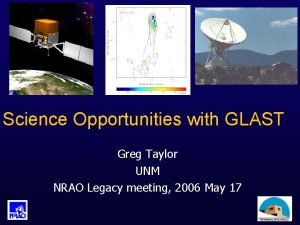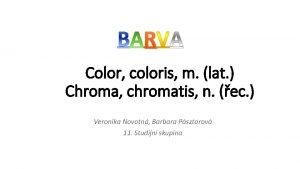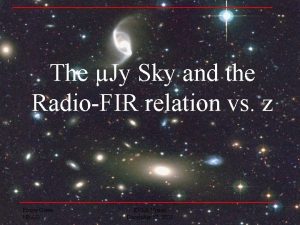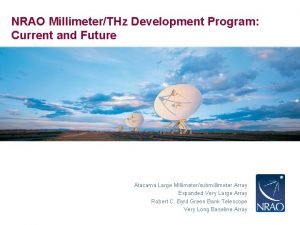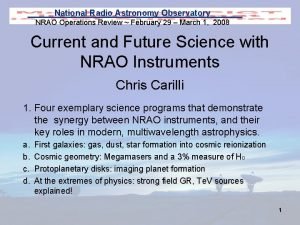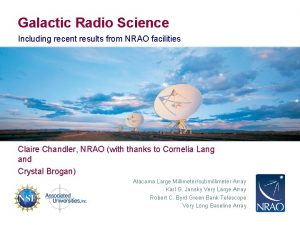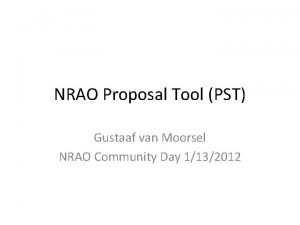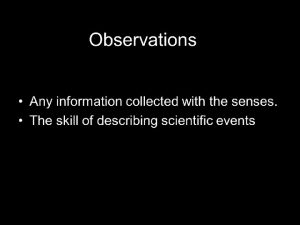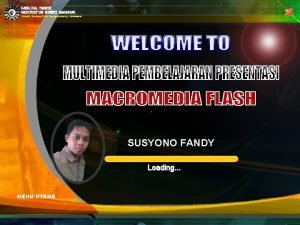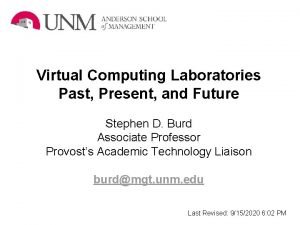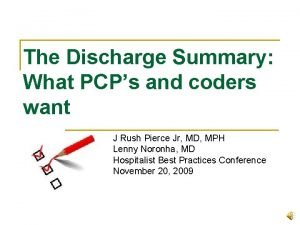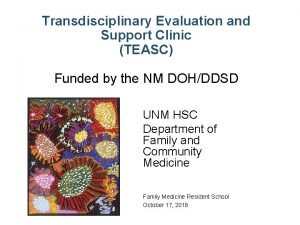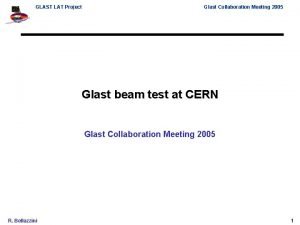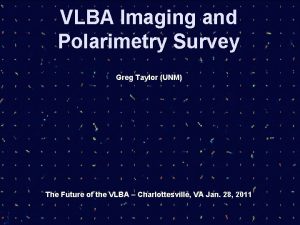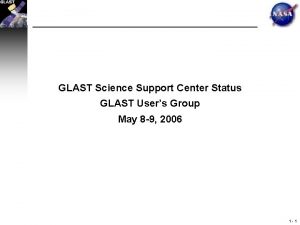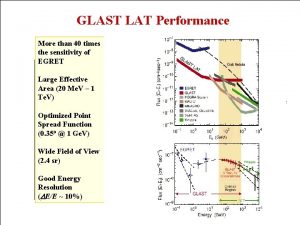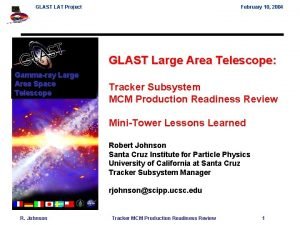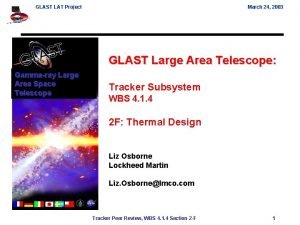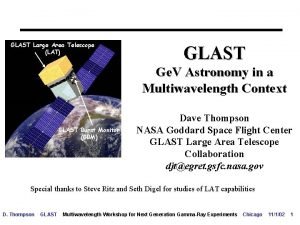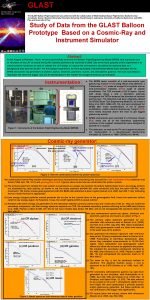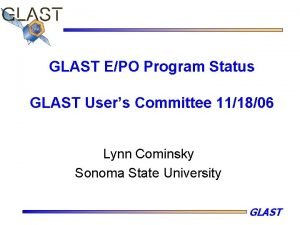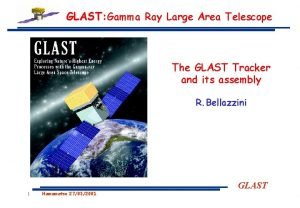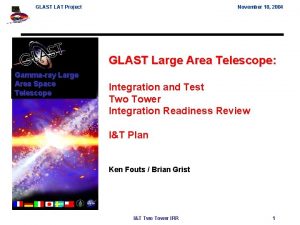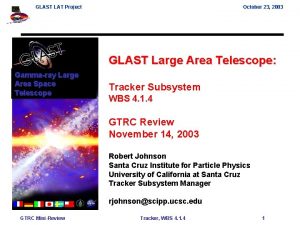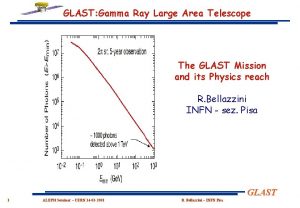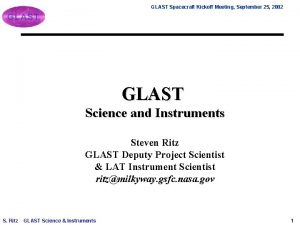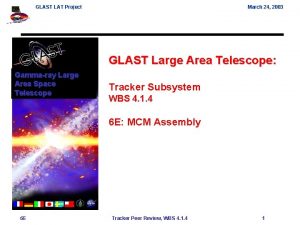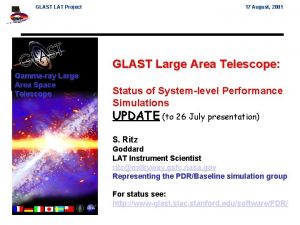Science Opportunities with GLAST Greg Taylor UNM NRAO
























- Slides: 24

Science Opportunities with GLAST Greg Taylor UNM NRAO Legacy meeting, 2006 May 17

LWA Discovery Space

FSRQ -- `Red’ Blazar Flat optical (FSRQ spectrum) Faint IC X-ray High z Blazar SEDs HBL -- `Blue’ Blazar Blue Optical (BL Lac spectrum) Bright Syn X-ray Low z Radio selection indiscriminate X-ray selection (eg. ASI sample HBL) cm selection

AGN spectra

3 EG Blazar Follow-up Survey • EGRET sources -- start from 3 EG (some are spurious!!) – Select flat spectrum • (NVSS/SUMSS+CLASS/new VLA/ATCA 8 GHz <1” resol. ) • Fo. M approach: increasing weight with large Sn, small a – Including X-ray, -ray position: • Total Fo. M has weak X-ray weight – Optical ID of high Fo. M, R<22 w/ Hobby*Eberly Telescope • Optical Arecibo DEC>-10

3 EG Survey Status 186 High b --115 Blazar -- 2 PSR/PWN --66 Non-Blazar (many questionable SRCs) -- 3 TBD >60% High b sources identified as blazars Romani et al

Large Area Telescope: Overview GLAST is composed of two instruments: - Large Area Telescope (LAT) - Gamma-ray Burst Monitor (GBM) Subsystems work together to identify and measure the flux of cosmic -rays: Silicon Microstrip Tracker Measures direction identification Orbit 565 km, circular Calorimeter Measures energy Shower imaging Inclination 28. 5 o Lifetime 5 years (requirement) 10 years (goal) Launch Date Fall 2007 e+ e– Anti-Coincidence Detector Rejects background of charged cosmic rays segmentation removes self -veto effects at high energy

LAT Current Status ØLAT is fully integrated (ACD + Tracker + Calorimeter) ØTest and calibration with data from cosmic ray showers. Actual Data

Summary of LAT strengths for AGN Science • FOV ( > 2. 4 sr ; 20 % of the sky at any instant!) • All-sky coverage in survey mode (samples the entire sky every 3 hours) • Effective Area (factor >4 better than EGRET: ~ 1 m 2 for E > 1 Ge. V) • Energy Range ( 20 Me. V - > 300 Ge. V) (including the unexplored E > ~10 Ge. V energy range) • Resolution 2’ at 10 Ge. V (factor > 3 better than EGRET for E > 1 Ge. V)

GLAST EGRET Gamma-Ray Sky GLAST (2007) E< 10 Ge. V), 1991 -1994 – (100 Me. V< – Diffuse >30 x EGRET sensitivity – Galactic plane emission + 271 – sources Expect 4000 -10, 000 Blazars, >200 Pulsars

Radio Target List • Selection S 4. 8>65 m. Jy, |b|>100, a<0. 5 -- CLASS+ – 10, 931 srcs [99. 9% obs, finished w/ VLA run last month (orange)] – Attempts to fill in PMN holes w/ S 5, lower n-selected sources – `CLASSIER’? CLASS Including Extra Regions

Downselect to CGRa. BS • Use Fo. M (S 8. 4, a, SX) trained against 3 EG • Candidate Gamma-Ray Blazar Survey – 1520 sources – These are the best and brightest of the EGRET-like Blazars • Optical Follow-up – Hard work! – – – Archival/SDSS Most at Mc. Donald Observatory (HET/2. 7 m) Handful w/ Palomar 5 m, trying for some 10 m time Some CTIO in South, few on SALT queue ESO NTT (4 nights August) requesting more NTT, VLT time

VLBI Imaging in Preparation for GLAST VLBA Imaging Polarimetry Survey (VIPS) • 1127 sources: S > 90 m. Jy, 65 > dec > 20, |b|>10 at 5 GHz in SDSS northern cap • First epoch observations on the VLBA in 2006 • Identifications and redshifts from SLOAN, HET, Palomar, … • Goals: - Characterize GLAST sources - Understand polarization properties of AGN classes - Study AGN environments - Find close binary black hole systems http: //www. phys. unm. edu/~gbtaylor/VIPS/

VIPS - VLBI Imaging and Polarimetry Survey The VIPS team is: Greg Taylor (UNM/NRAO), Joe Helmboldt (UNM), Steve Healey (Stanford), Steve Myers (NRAO), Tim Pearson (Caltech), Neil Gehrels (NASA GSFC), Peter Michelson (Stanford), Chris Fassnacht (UCD), Larry Weintraub (Caltech) Craig Walker (NRAO), Lorant Sjouwerman (NRAO), Tony Readhead (Caltech), Roger Romani (Stanford), Roger Blandford (KIPAC)

VIPS on the web 432 new sources correlated to date http: //www. phys. unm. edu/~gbtaylor/VIPS/

Oddballs in VIPS

Oddballs in VIPS page 2

Oddballs in VIPS page 3

Previous AGN surveys at mas resolution Pearson-Readhead (PR - 1988): 5 GHz, 35 sources Caltech-Jodrell Bank (CJ 1 - 1995): 1. 7 and 5 GHz, 65 sources Second Caltech-Jodrell Bank (CJ 2 - 1994): 5 GHz, 192 sources CJ Flat spectrum (CJF – 1996): 5 GHz, 293 sources VLBA 2 cm survey (2000): 15 GHz, 132 sources VSOP pre-launch survey (1998): 5 GHz, 374 sources USNO geodetic survey (2004): 2. 2 and 8 GHz, 452 sources Polarization: partial observations at a single frequency for PR and CJF Multi-epoch: PR, CJ, VLBA 2 cm, USNO, MOJAVE

0402+379 Rodriguez et al. 2006 A Close Binary Black Hole


Multi-wavelength observations of AGNs • The large FOV will allow GLAST to catch AGN flares consistently: - Many EGRET sources were only observable during flares, GLAST will provide detailed lightcurves on a wide range of timescales during flares and quiescent states - GLAST can serve as a trigger for observations at other wavelengths, including a VLBA monitoring campaign - VIPS provides a reference epoch for ~1000 gamma-ray bright AGN Simulated 5 -year GLAST lightcurve PKS 1622+297 1996 EGRET flare GLAST simulation

GLAST and Community • Data release plan: – All transients sources are immediately public – During the first 12 months of science operations, data from specific sources of interest will be made available: (Preliminary) 0208 -512, PKS 0528 -134, Mrk 421, 3 C 273, 3 C 279, etc… – After the first 12 months of science operations, GLAST data is public • Multi-wavelength observations are required for maximum scientific return: – VLBI studies of jet motions, broadband SED modeling – For transients and unidentified sources, having simultaneous observations may be the only way of positive identification – Redshift determination is fundamental to many studies.

Conclusions • GLAST will increase the g-ray source catalog by > 30 • Efficient observing mode, improved sensitivity and increased effective area combine to provide superb monitoring of the Ge. V sky on timescales from hours to years • GLAST observations will result in a deeper understanding of: - Acceleration and emission mechanisms of AGNs - Test of the unification model and blazar sequence - Luminosity function of g-ray sources and its cosmic evolution • GLAST is coming soon, we should be prepared to maximize the science return
 Greg taylor unm
Greg taylor unm Glast tm
Glast tm Xanthodermia
Xanthodermia Nrao
Nrao Nrao
Nrao Nrao
Nrao Nrao
Nrao Mynrao
Mynrao Spinal
Spinal Conversation about favorite subject
Conversation about favorite subject Francois-emanuel fodere
Francois-emanuel fodere Unm internal medicine residency
Unm internal medicine residency Registrar unm
Registrar unm Alamat unm parangtambung
Alamat unm parangtambung Hasrul bakri unm
Hasrul bakri unm Unm vlab
Unm vlab Unm hospitalist wiki
Unm hospitalist wiki Unm hrpo
Unm hrpo Chrome river unm
Chrome river unm Unm im residency
Unm im residency Unm center for neuropsychological services
Unm center for neuropsychological services Sister unm makassar
Sister unm makassar Ob triage unm
Ob triage unm Learningcentral unm
Learningcentral unm Unm lobo web
Unm lobo web
